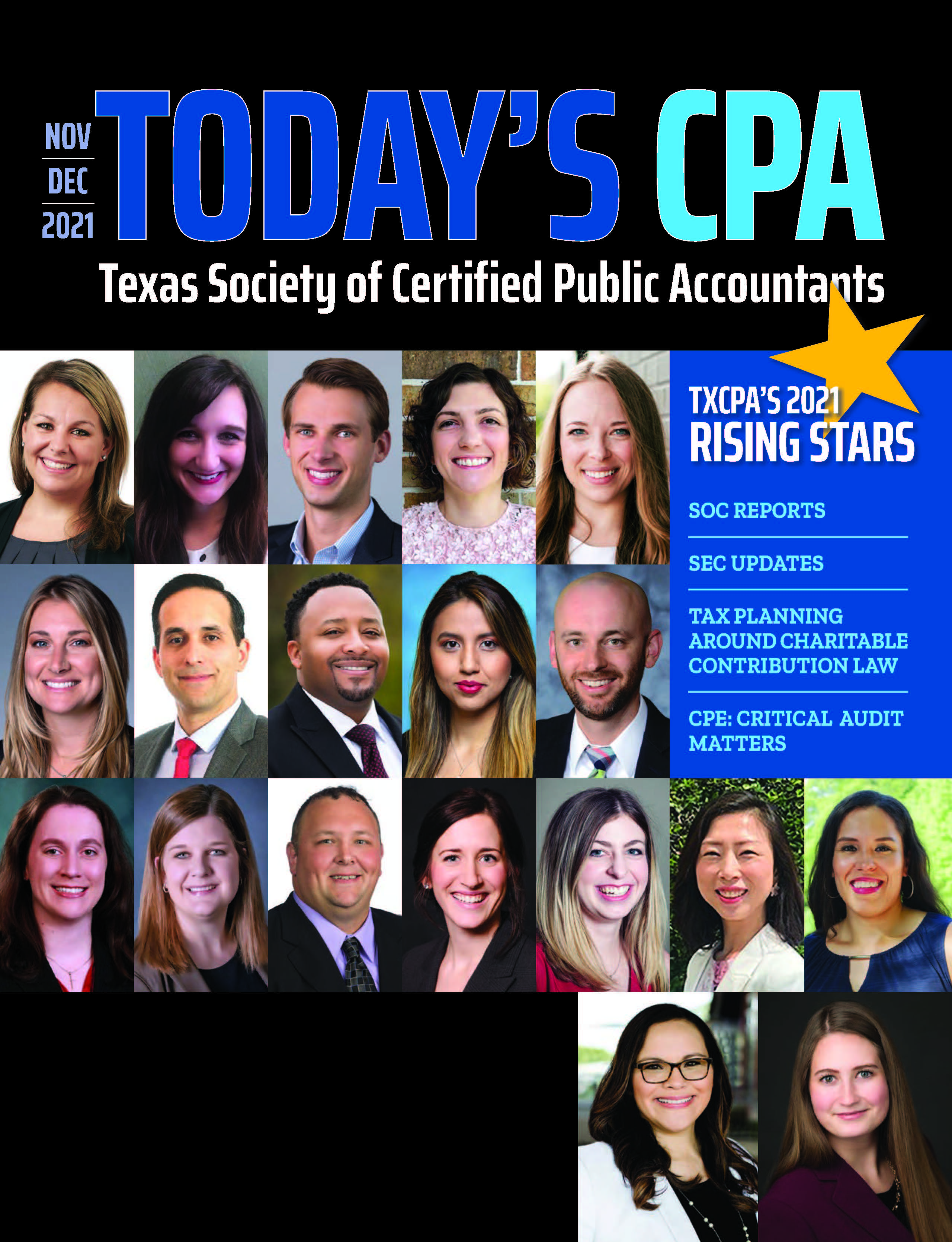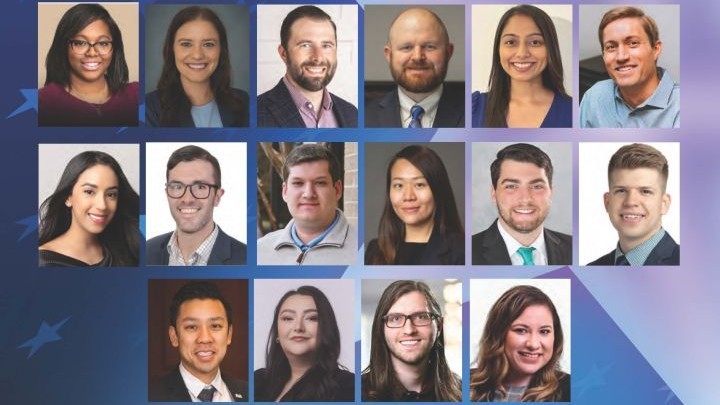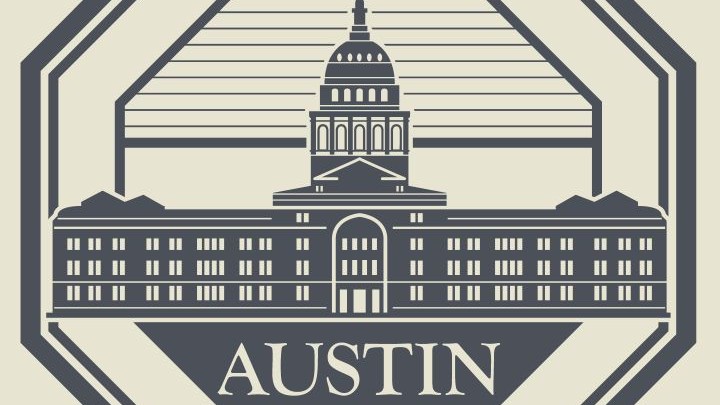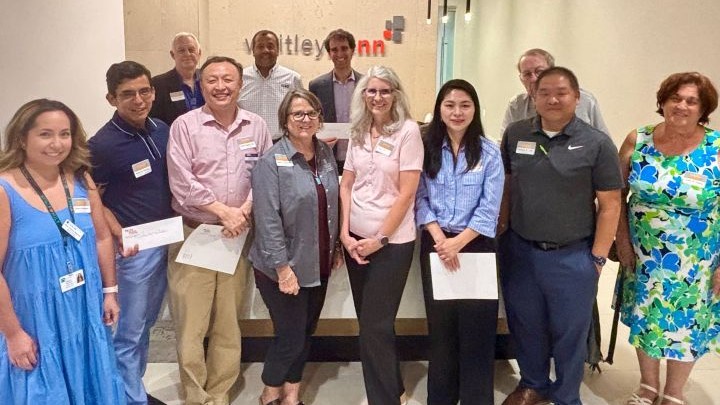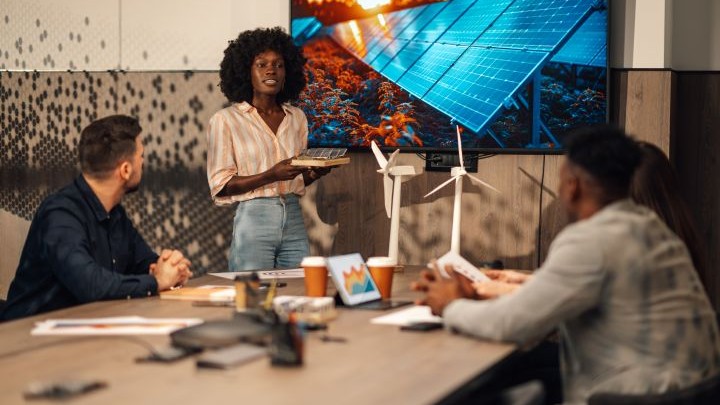Tax Planning Around Changing Charitable Contribution Law
TAX TOPICS COLUMN
By Jim Martin, CPA, and John M. Collar
As tax professionals, CPAs are conditioned to expect annual tax law changes and to then assist clients in preparing for the changes. Taxpayers, on the other hand, have varying levels of understanding of tax law changes and are motivated by many things other than income tax planning.
Some tax law changes substantively affect taxpayers and may offer opportunities for taxpayer benefit if properly planned for. This article focuses on recent tax law changes that dramatically reduced the number of taxpayers who itemize. It then examines the level of charitable giving, possibly in anticipation of the changes in the tax law related to itemized deductions.
Put another way, we ask the questions: If taxpayers knew that the deductibility of their charitable contributions would be dramatically changing next year, would they give more or less this year to incur a tax benefit? Further, was this tax-driven decision to increase or decrease charitable giving possibly affected by taxpayer religiosity? Or was the taxpayer’s anticipatory level of giving possibly affected by suspension of the Pease limitation in 2018?
Finally, this research is particularly timely. It is based on IRS provided taxpayer data for the nearly 1/3 of individual taxpayers who itemized before 2018. As explained herein, future research using IRS data will be far less comprehensive given the huge drop in the number of itemizing taxpayers beginning in 2018.
The typical individual taxpayer will calculate his/her federal taxable income by deducting the larger of his/her itemized deduction or standard deduction from adjusted gross income. The Tax Cuts and Jobs Act (TCJA) was signed into law in October 2017, with most of the resulting tax law changes taking effect in 2018.
One of the more substantive changes was the marked increase in the standard deduction. In 2017, the standard deduction for a single taxpayer was $6,350 and a married filing jointly was $12,700. In 2018, the standard deductions were increased to $12,000 for single and $24,000 for married filing jointly taxpayers. In addition, changes were made that restricted or eliminated the deductibility of casualty losses, home mortgage interest, state and local taxes, and miscellaneous items as itemized deductions.
The effect of increasing the standard deduction and the new restrictions on itemized deductions has reduced the percentage of taxpayers who itemize from approximately 30% pre-TCJA to approximately 10% post-TCJA. Charities have voiced concerns that if most taxpayers no longer can deduct their itemized deductions, will their expenditures for charitable contributions be reduced?
The answer to that question will come from the analysis of 2018 information and thereafter. Much of that information on charitable contributions will have to come from non-IRS sources, will only represent approximately 10% of taxpayers and is beyond the scope of this article.
The 2018 heretofore mentioned changes that reduce available tax information for itemized deductions such as charitable contributions occurred not because the IRS stopped reporting information to the public. Taxpayers still make contributions and in limited cases, still deduct them. The 2018 change occurred because tax law changes effective in 2018 essentially ended the itemized charitable contribution deduction for the majority of taxpayers who had previously itemized. The IRS information is still there, but it now only includes the roughly 10% of individual taxpayers who still itemize.
This article’s analysis is essentially a last look at reliable broad-spectrum charitable contribution information from the IRS. The analysis is in three parts.
Part 1: What are recent trends in charitable giving levels? Our analysis focuses on taxpayer contribution levels by income segment, including the average contribution amount for each income level.
Part 2: Focusing on 2017, is there any evidence of taxpayers increasing or decreasing their contributions in anticipation of tax law changes in 2018?
Part 3: If evidence exists that taxpayers at a certain income level increased their giving in 2017, did this level of increased giving vary by state? Further, did states with greater levels of religiosity more rigorously participate in this charitable contribution “front loading?”
Recent Trends in Charitable Giving
IRS tax statistics are published annually and provide detailed income and deduction information for 10 income brackets. To simplify the analysis, these 10 brackets were combined to form three income tertiles.
IRS bracket #1 includes information for taxpayers with taxable income below a dollar. This bracket was excluded from analysis since those taxpayers typically do not itemize.
IRS brackets #2-4 were combined to form tertile #1. These were taxpayers who earned from $1 to $49,999.
Similarly, IRS brackets #5-7 were combined for tertile #2 with taxable earnings of $50,000 to $199,999. IRS brackets #8-10 were combined to form tertile #3, with earnings above $199,999. Calculations of two data points were calculated for years 2014-2017 for each income tertile. These data points were:
• Percentage of taxpayers making a charitable contribution deduction; and
• Average charitable contribution per taxpayer.
As expected, results in Table 1 show the average charitable contributions trending upward over time for all income tertiles, while the percentage of taxpayers actually claiming the charitable contribution deduction trended slightly downward over time for all tertiles. Total charitable contributions deducted for all individual taxpayers went from $147.8 billion to $152.5 billion during the 2014-2018 period.
Evidence of Possible “Front Loading” of Charitable Contributions in 2017
“Front loading” is the increase in the amount of a deduction, such as charitable contributions, in a given year by accelerating the payment of the deductible expenditure from a future year.
This acceleration could be because the expenditure is deductible in the year of acceleration (such as 2017) and not in the year it was originally expected to be made (such as 2018). Front loading is legal and can be a good tax strategy.
Table 2 was prepared to compare the annual percentage increase in charitable contributions deducted in 2017 for the average taxpayer when compared to the compound average annual percentage increase in the 2014-2016 period. If the 2017 increase is greater than increases in prior periods, it could be an example of front loading.
The 2017 calculations of the percentage increase were made separately for each of the three income tertiles. Results showed that the 2017 percentage increase in individual taxpayer contributions for the lowest income tertile was slightly lower than in prior years. The highest income tertile showed a considerably smaller increase in 2017 when compared to the compound annual growth rates for 2014-2016. These smaller increases would not be evidence of front loading of contributions for these income brackets.
No additional analysis was done to identify reasons for this decrease. Given there are many motives for making charitable contributions other than the tax benefit, these other motives should be considered.
Certainly, the lack of financial wherewithal to accelerate contributions may have constrained the first tertile (lowest income) decrease. The third tertile’s (highest income) smaller increase could actually reflect the opposite of front loading, that is a shift in charitable contributions from late in 2017 to 2018. Reasons for this include a new ability to take advantage of the TCJA’s suspension of the Pease limitation beginning in 2018. This high income tertile also includes the most likely set of taxpayers who would still be itemizing in 2018 and thereafter. This delay in giving would allow for a greater tax benefit from charitable contribution in 2018 for some high-income taxpayers when compared to 2017, a year when the Pease limitation was in effect.
The Pease limitation was enacted by the Omnibus Budget Reconciliation Act of 1990. It serves to reduce the deductibility of certain itemized deductions, including charitable contributions, for higher income individuals. The reduction in itemized deductions is equal to the lesser of 3% of taxpayer AGI above a threshold (e.g., $313,800 for married filing jointly in 2017) or 80% of the taxpayer’s itemized deductions. This deduction limitation was in effect in 2017, but suspended beginning in 2018 under the TCJA.
The second tertile (middle income) did show a marked increase in 2017 contribution growth over the 2014-2016 percentages. This unsurprising result could be evidence of a set of taxpayers with the financial wherewithal to accelerate charitable contributions into 2017 from 2018. These taxpayers could view 2017 as the last year in which the deduction of itemized deductions is practical given the announced increase in the 2018 standard deduction for 2018 and thereafter.
Analysis of Charitable Contributions and Religiosity
People possess varying levels of religiosity, that is, the feeling of being religious. In 2014, the Pew Foundation completed a religious landscape study that sought to calculate the level of religiosity by state.
This study was used as this article’s basis to rank each state by its level of religiosity. Information for all 50 states was used to divide the states into five categories: Lowest Religiosity, Lower Religiosity, Average Religiosity, Higher Religiosity, and Highest Religiosity. Table 3 lists the states placed in each of these categories.
To facilitate the analysis of the possible impact of religiosity on charitable contributions, Table 4 was prepared, which calculates the annual percentage of taxpayers (with positive taxable income) who claimed a charitable contribution deduction in each of the years 2014-2017.
In examining the Table 4 results for all taxpayers, those states with the lowest and the lower levels of religiosity consistently had a greater percentage of taxpayers claim charitable contribution deductions when compared to the taxpayers in states with the average, higher and highest religiosity.
This surprising result prompted a deeper dive into the information to see if some of this behavior could be linked to income levels within the various levels of religiosity. The further analysis discussed below also revisits the possibility of front-loading behavior in 2017 in the varying religiosity groups.
Separate calculations were made for each of the three taxable income tertiles. Whereas Table 4 groups all income levels together, Tables 5 through 7 extend the analysis and examine each income segment separately.
Charitable Contributions and Possible Front Loading in the Lowest Income Tertile
Table 5 calculates three things: the percentage of taxpayers in the lowest income tertile ($1-$49,999) making charitable contributions, the average amount of those contributions, and the compound percentage increase or decrease for the periods 2014-2016 and 2017, the year prior to the tax law change. Separate calculations are made for each level of religiosity within the income tertile.
Notable findings include the following:
• The percentage of taxpayers within this income level who made charitable contributions was fairly consistent across all levels of religiosity except for those taxpayers in the higher religiosity segment. This segment displayed a notable lower percentage of taxpayers making contributions when compared to the other religiosity segments.
• The average dollar contribution per taxpayer in this income tertile increased as the level of religiosity grew. This was true for all years.
• When checking for possible front loading in 2017, there was little observable evidence of possible occurrence. Evidence of possible front loading would have been a marked increase in the annual contribution growth rate in 2017 when compared to 2014-2016.
Charitable Contributions and Possible Front Loading in the Middle Income Tertile
Table 6 calculates the same data points as Table 5 for the middle income tertile ($50,000-$199,999) by level of religiosity. Notable points include the following:
• The percentage of taxpayers in this middle income tertile who make charitable contributions was fairly consistent across the levels of religiosity except for those taxpayers in the higher religiosity segment. The higher religiosity segment displayed the lowest percentage of contributing taxpayers.
• The average contribution per taxpayer in this income tertile increased in all years as the level of religiosity grew.
• When looking for evidence of possible front loading, in 2017, the highest religiosity segment showed the greatest increase in 2017 giving when compared to the 2014-2016 levels. This highest level of religiosity showed the greatest example of possible front loading.
Charitable Contributions and Possible Front Loading in the Top Income Tertile
Table 7 calculates the same data points as Table 5 and 6 for the top income tertile ($200,000 and above) by level of religiosity. Notable points include:
• Like the other income tertiles, the percentage of taxpayers who made charitable contributions was lower in states with higher religiosity.
• The average contribution per taxpayer was actually greatest in the lowest and the highest religiosity segments. Unlike the other income tertiles, the average contribution per taxpayer did not increase every year in all cases.
• When looking for evidence of possible front loading, the percentage increases for the top three religiosity segments showed possible front loading in 2017. However, the average change in giving actually showed a decrease in 2017 for the two lowest levels of religiosity. Motives for the behavior of the top three religiosity segments could include delaying contributions until 2018, while the decreases associated with the lower two levels of religiosity could reflect taxpayers delaying giving and taking advantage of the suspension of the Pease limitation.
Changes in Behavior
Compared to 2018, tax laws in place in 2017 included a relatively low standard deduction and made it easier for taxpayers to deduct charitable contributions as an itemized deduction. Some taxpayers at lower income levels still found it advantageous to take advantage of the standard deduction, while taxpayers with greater levels of income were more likely to itemize in the periods analyzed.
Changes in tax law evoke changes in behavior. In anticipation of the 2018 tax change, an opportunity to front load contributions existed in 2017. Possible evidence of this front loading was present for income levels of $50,000-$200,000 and income levels above $200,000.
The 2018 tax law change also suspended the Pease limitation. This offered some high-income taxpayers a tax savings opportunity for contributions made in 2018 when compared to contributions made in 2017. Some possible evidence of taxpayers taking advantage of this was present in 2017 for taxpayers with incomes above $200,000.
A taxpayer’s level of religiosity may also affect their willingness to take advantage of these tax law changes. For the middle-income taxpayers ($50,000-$200,000), there is evidence of possible front loading by taxpayers in the top three religiosity segments
There is even greater evidence of this possible behavior in the top three religiosity segments of high-income taxpayers (above $200,000).
When examining the information for a possible delay in taxpayer charitable contributions from 2017 into 2018 to avoid the Pease limitation, some evidence of this behavior was noted for the two lowest levels of religiosity in high-income taxpayers.
Because charitable contributions are motivated by reasons other than tax savings, additional research into the other drivers of charitable contributions and their timing is warranted.
About the Authors: Jim Martin, CPA, is an MPA graduate of the University of Texas at Austin and is the Henrietta and G.W. Snyder Jr. Professor in Business at Washburn University in Topeka, Kansas. He can be reached at jim.martin@washburn.edu. John M. Collar holds a Bachelor of Arts from the University of Kansas and is a student in the Washburn MAcc program. He can be reached at john.collar@washburn.edu.
